2022 Full Fibre Country Ranking Sees UK Overtake Germany

The FTTH Council Europe has today released their annual ranking of the European countries with the strongest subscriber penetration and annual growth of gigabit-capable “full fibre” (FTTP/H/B) broadband ISP networks. Happily, the UK continues to show exceptional growth, and has managed to leapfrog over Germany.
The good news is that the United Kingdom has continued to show strong growth, but it remains a slow climb to catch up with countries that have been building at scale for many years longer. Until three years ago, the UK didn’t even appear in the council’s ranking, but the massive and predominantly commercial rollout of Fibre-to-the-Premises (FTTP) networks has steadily been changing that (Summary of Full Fibre Builds).
Back in 2019 the UK had an annual FTTP growth rate (homes passed in %) of 22.8%, which hit 50.8% in 2020, then 64% in 2021 and in this year’s report we’ve reached 80%. The other fastest growing countries of the year were Belgium 109%, Greece 90%, Cyprus 83% and Austria 62%.
Advertisement
As before, much of this improvement has been fostered over the past 5 years by the Government’s increasing support for “gigabit-capable” networks, such as via their business rates holiday on new fibre (sadly, this just ended), as well as connection vouchers, various other funding schemes (here) and regulatory improvements via Ofcom to support investment (here).
Most of the coverage achieved so far reflects commercial builds in urban areas and this is expected to help push UK coverage up to around 80% by the end of 2025 (e.g. Openreach’s build alone should hit 25 million premises by December 2026, and they’re just one of many players). After that, the Government’s new state aid funded £5bn Project Gigabit aims to tackle the final 20% of hardest to reach (predominantly rural) premises by 2030.
Suffice to say, fibre optic network growth is exceptionally strong in the UK, and it’s going to stay that way for the next few years.
The 2022 FTTH Country Ranking
The latest data shows that the UK now has a market penetration rate of 6.3% (up from 3.7% last year), a coverage figure of 26.6% or 7.7 million homes passed (up from 15.1%) and a take-up rate of 24% or 1.8m subscribers (down from 25% last year) – the latter reflects an annual growth in subscribers of 73%. We should point out that Ofcom’s figure for full fibre coverage in that same month was 28% (here), so this sounds about right.
Advertisement
The slightly lower take-up rate than last year should not be seen as a cause for concern. Markets where FTTP/B is already at a mature level of deployment will naturally have significantly higher take-up, while those where the technology is in the process of rapid deployment are always the opposite (i.e. the pace of build is so fast that it suppresses the take-up figure, when expressed as a percentage).

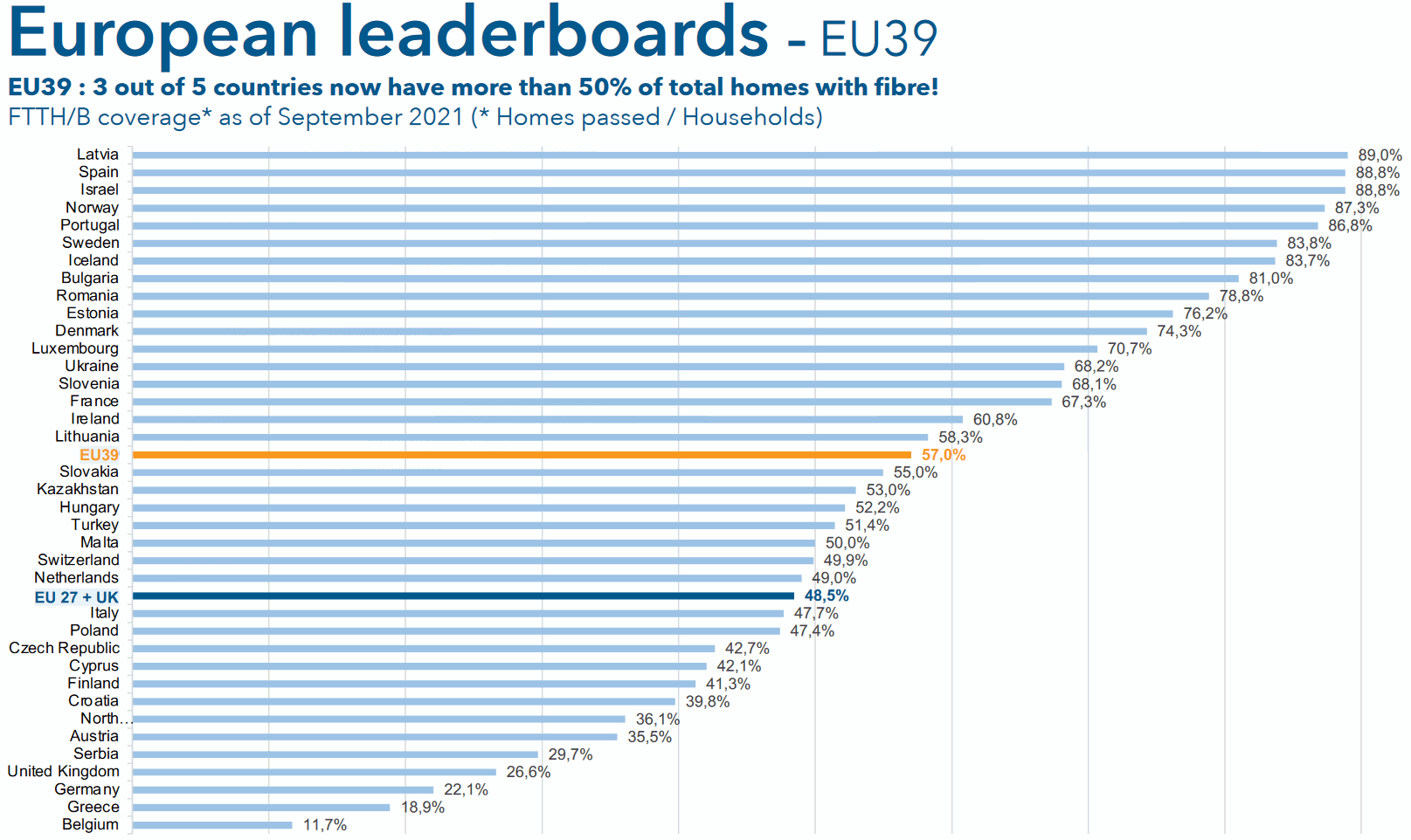
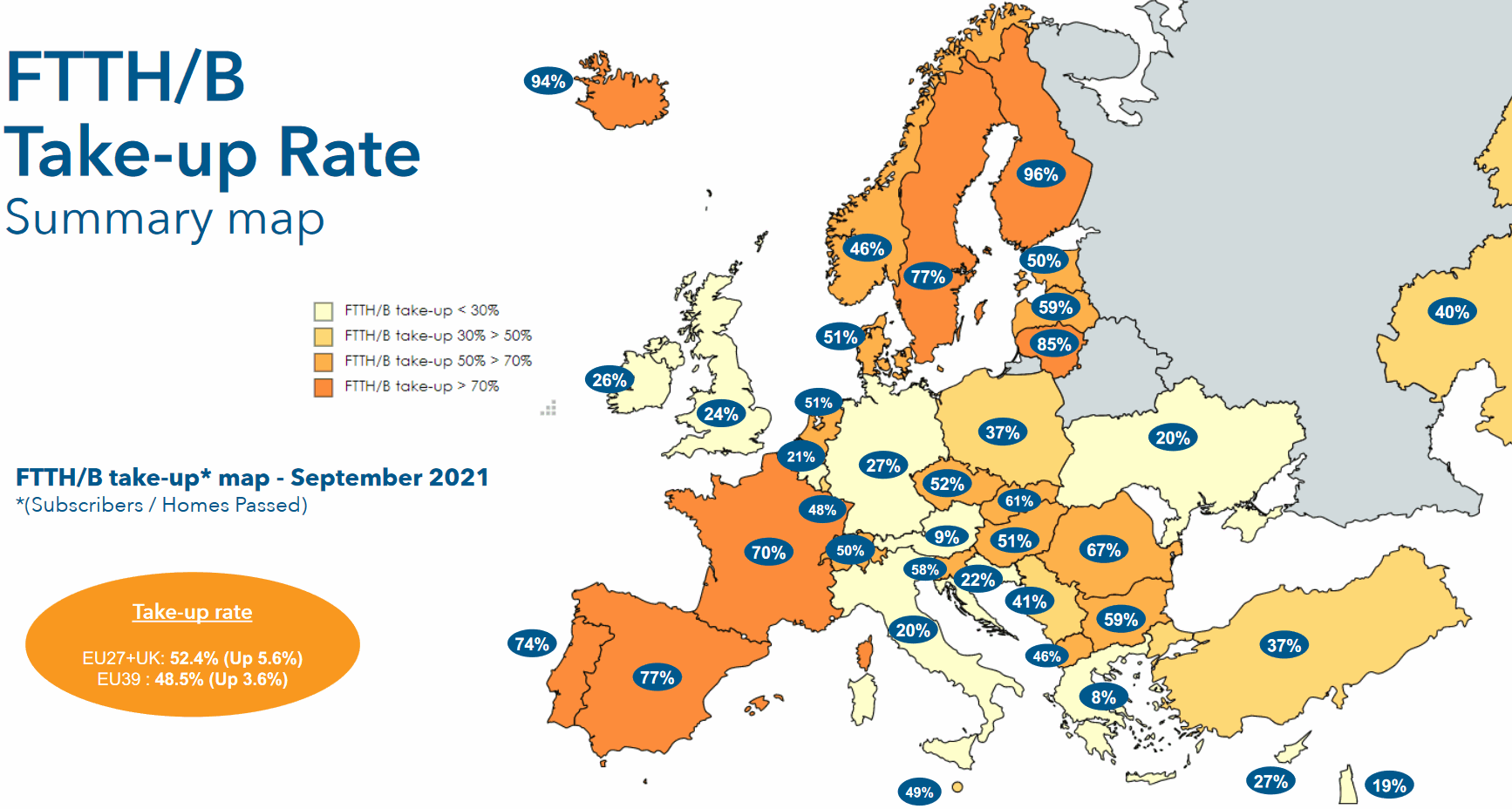
Advertisement
As mentioned earlier, the data indicates that FTTP/B coverage in the United Kingdom grew by 80% over the past year (+3.4 million extra premises), which is up from 64% in the previous year (+1.7 million extra premises). The rapid improvement in annual coverage also saw the UK overtake Germany in the penetration table (Germany added 2.4 million extra premises).
Overall, the total number of homes passed with FTTP/B style broadband networks in the European countries surveyed reached 198.4 million (up from 176.3 million last year). The other main movers in terms of homes passed in absolute numbers were France (+4.3 M), Germany (+2.4 M) and Italy (+1.5 M). We should add that Russia and Belarus were excluded from this year’s study.
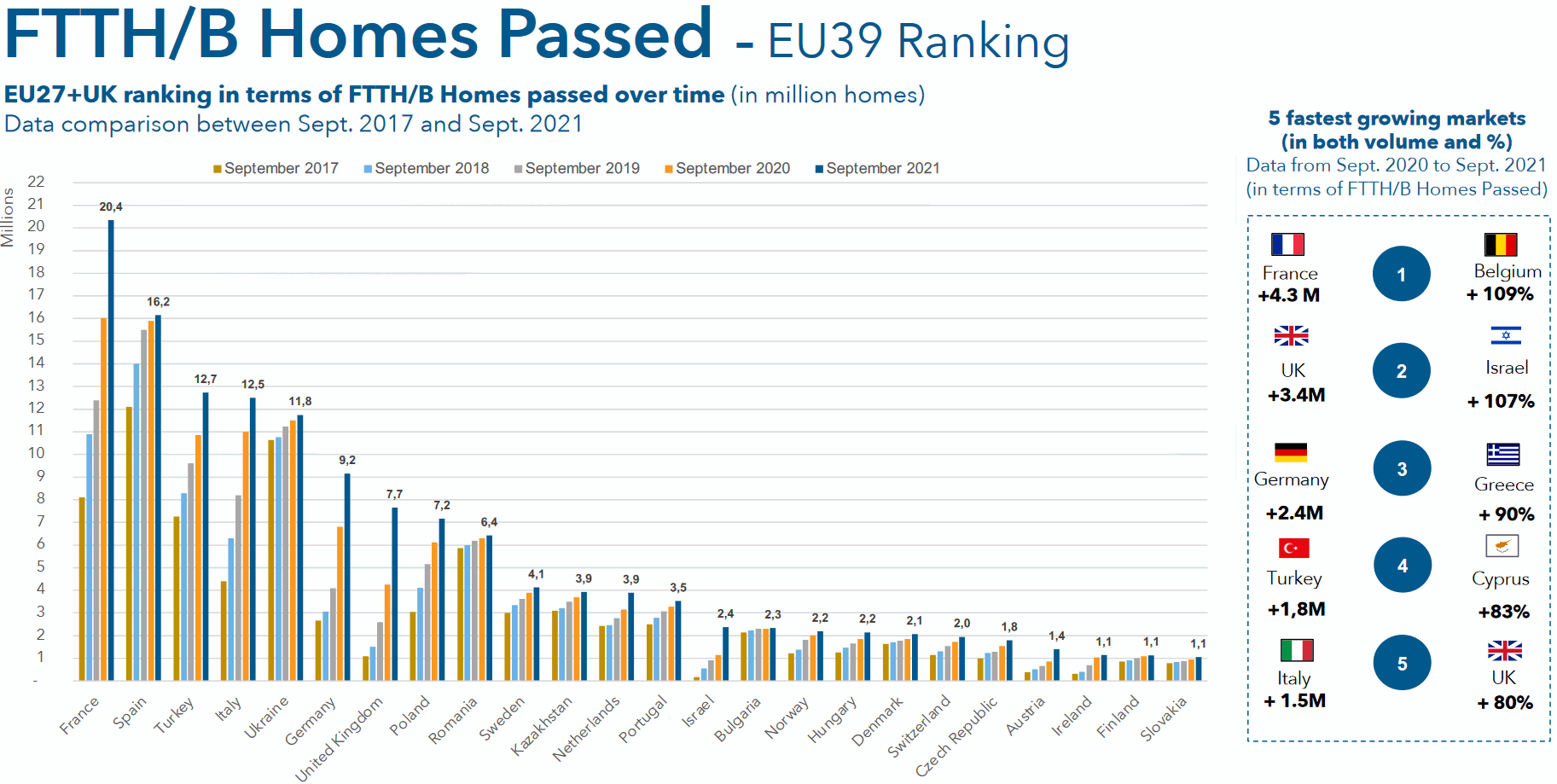
In terms of future progress, the council’s report notes that the UK, Germany and Italy still have a long way to go in terms of build. The UK has about 21.07 million premises left to reach, while Germany needs to do 32.35 million and Italy has another 13.7m in the pipe. But the same report forecasts that the UK will reach 30.1m homes by the end of 2027, with some 11.1m subscribers.
We suspect that FTTP/B take-up in the UK will still be a growth market in 2027, much like FTTC before it, once that technology reached a similar level of maturity in national coverage.
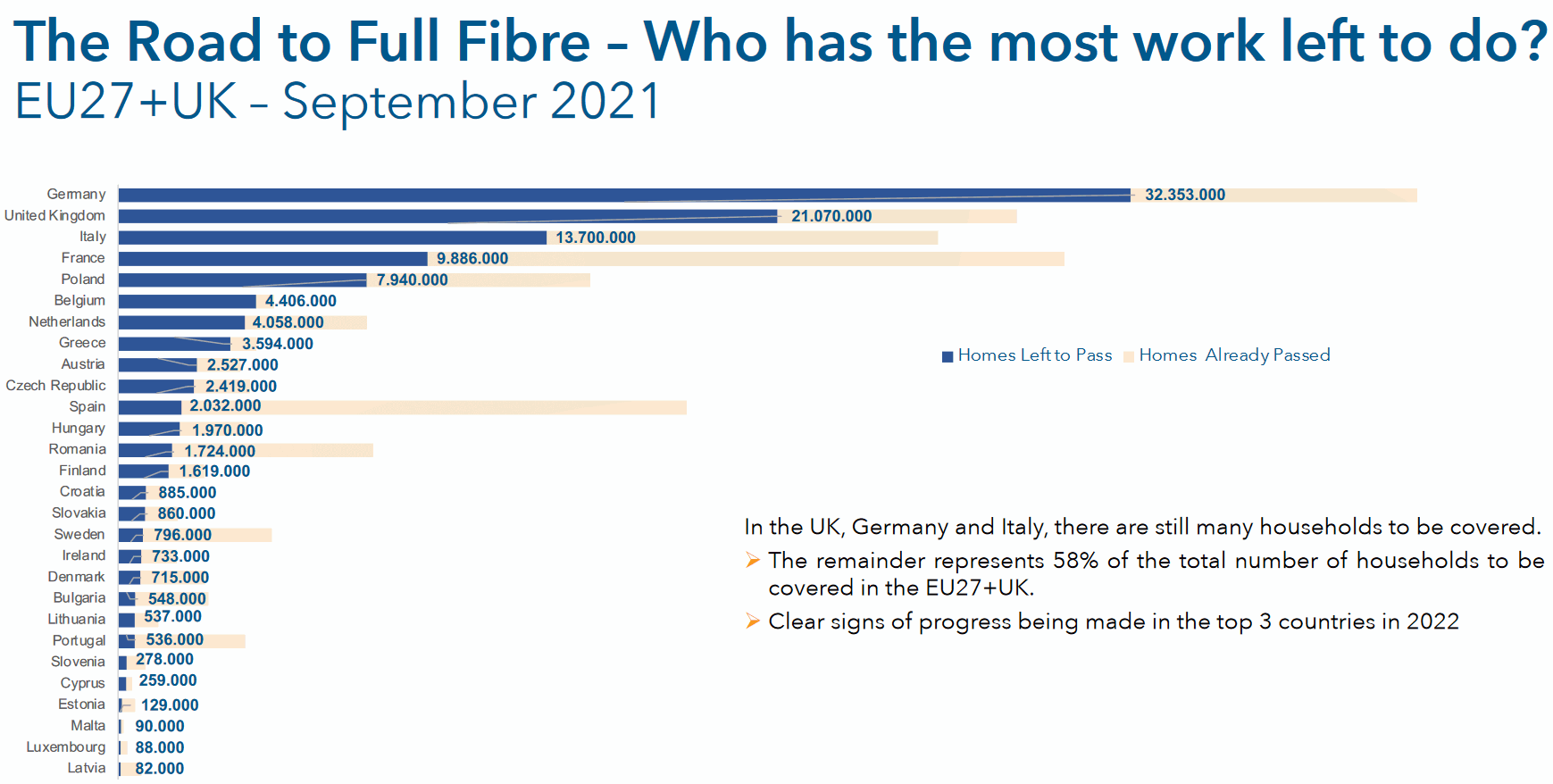
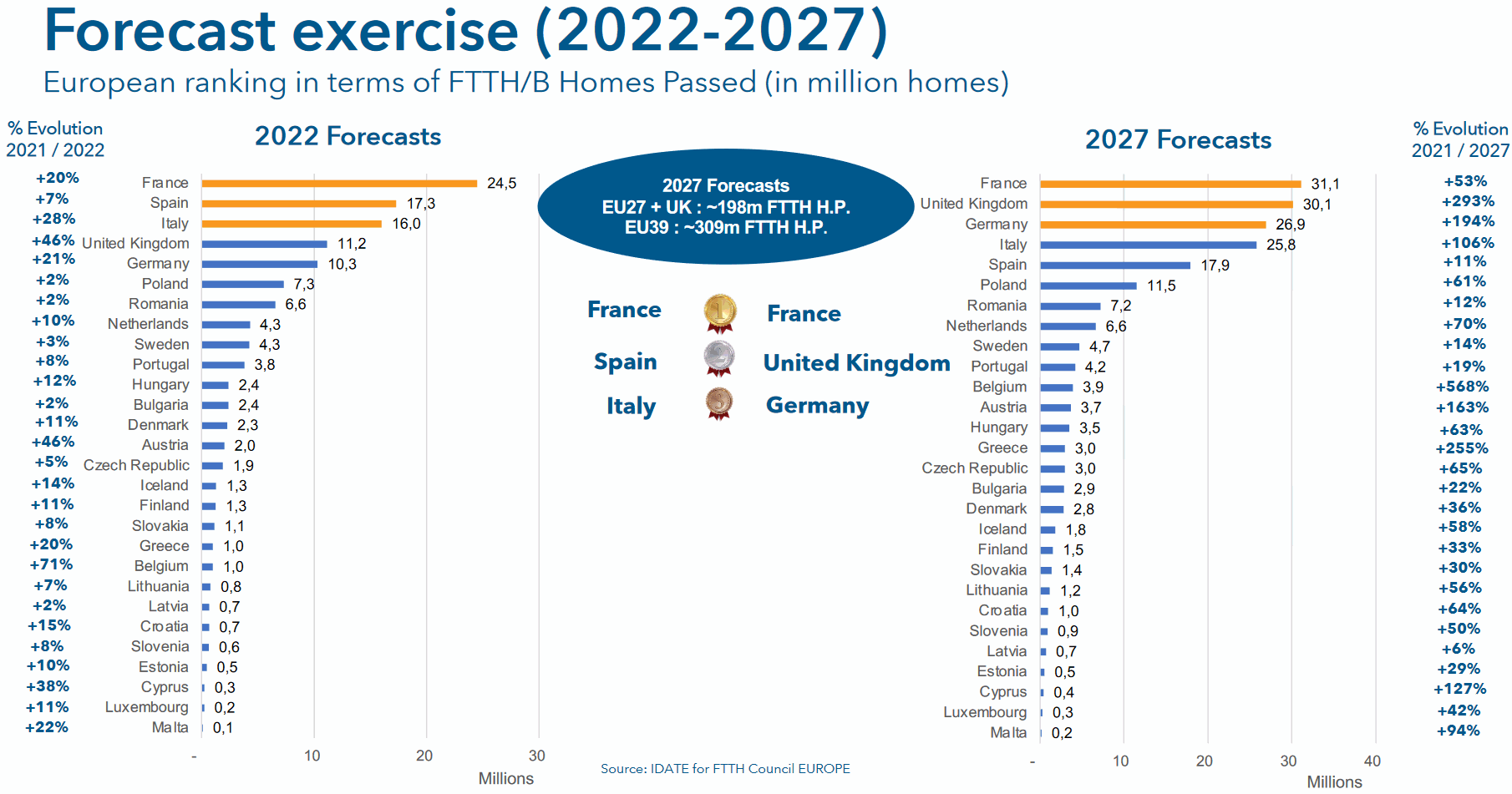
Alternative network ISPs (Cityfibre, CommunityFibre, Gigaclear etc.) are still constituting the largest part of FTTH/B players, with around 57% of the total homes in the EU39 being passed by alternative ISPs and around 39% by the incumbent ISPs, with the remaining 4% being municipalities/utilities. Overall, there is a strong trend of acceleration of fibre deployment, with a firm commitment to cover both urban and rural areas.
Speaking of rural areas. The report shows that by September 2021, only 30% of rural inhabitants could enjoy capabilities offered by full-fibre connectivity (compared to the average number of 49% of European households in the EU27+UK region that are covered by FTTH/B networks).
The five countries with the highest Rural FTTH/B coverage are Denmark (76%), Latvia (74%), Spain (66%), Romania (62%) and Luxembourg (55%).
Vincent Garnier, Director General of the FTTH Council Europe, said:
“The data clearly shows that we are achieving a great progress in terms of fibre roll-out, thus contributing to the twin digital and green transition which will reshape how Europeans work, live and do business.
The full fibre connectivity will be key to achieve the EU’s ambitious climate and sustainability targets. Moreover, the Covid-19 pandemic led to more data traffic and more demand, clearly demonstrating the necessity to intensify FTTH deployment and adoption.”
Despite all this good progress, it’s worth remembering that slower hybrid fibre and copper line based broadband services (FTTC, ADSL etc.) will still be around for a fair few years. The Government’s Project Gigabit scheme is also technology neutral, which means that it can be achieved via the combination of other gigabit technologies too, such as Virgin Media’s Hybrid Fibre Coax (HFC) network and wireless solutions.
Nevertheless, most new deployments today are primarily focused on fostering full fibre services, which remains the technology of choice for the bulk of new contracts. But the UK is still playing catch-up with many other countries, most of which have been deploying full fibre, at scale, for a decade or so longer than we have. The advantage to arriving late is that we benefit from more mature technologies and deployment methods.
One final point to make is that country-to-county comparisons never tell the whole story. For example, some countries have funded the deployment of fibre almost entirely from public money, while offering very little in the way of competition (e.g. weak consumer choice). Meanwhile, other countries have a significantly larger proportion of people living in large blocks of flats (e.g. Spain, Portugal), which are much cheaper to serve than countries with a greater proportion of individual houses.
Mark is a professional technology writer, IT consultant and computer engineer from Dorset (England), he also founded ISPreview in 1999 and enjoys analysing the latest telecoms and broadband developments. Find me on X (Twitter), Mastodon, Facebook, BlueSky, Threads.net and Linkedin.
« BT Launch Hybrid 4G Speed Boost for SME Copper Broadband Lines






















































Given we are nearly at the bottom of the list it is not surprising we have moved up.
The huge amount of positives to be taken from this and that’s your take?
How’s the Hundred Acre Wood, Eeyore?
This is really promising. From a very late start the UK is looking like building more FTTP than any other nation in Europe over the next 5 years. Would’ve thought that’d be something to praise rather than dwelling on the past.
Paging G Newton to complain about how late this is, how slow it is and how unacceptable it is that it isn’t all symmetrical.
Be thankful it’s a list of Europe only and not the world – we’d be even further down once you add in places like Japan, South Korea, Hong Kong, Taiwan, Singapore.
South Korea has been trying to push 1G subscribers to take up 10G connections since at least 2019.
Those 5 are a given. Even the best in Europe might be behind them, but the UK is also behind Malaysia, Thailand, Vietnam, Indonesia, China, India, Pakistan, Laos, indonesia, the Philippines, etc. I would have expected us to be ahead of Laos, but we’re not (apparently). it does look like we’re ahead of Sri Lanka (and I would assume places like Myanmar and North Korea).
I’m confident that, with a new FTTP pole less than 100m away, which has been there nearly three years, Atlantis and Mars will have 100% FTTP before us, we are a place devoid of FTTC, yet surrounded by it, a place surrounded by FTTP, a place with excruciatingly slow unreliable ADSL, an area in a so called fibre first city declared ‘complete’ by openreach a year ago. We are the premises simply ‘passed’
I’m interested to know your postcode Martin E!
So I can see the bigger picture.
Same here. Whole street done other than my post. We are at the bottom of the road, close the to the FTTC cabinet. I am guessing Openreach couldn’t be bothered with out post since we can G.Fast with 250mb speeds so they figured that should be enough. I would have bought FTTP straight away if they upgraded our post. Here is the post in question, go up the road and you will see all the other posts have FTTP in them already…
https://goo.gl/maps/7yUpvnVy912oV2Xt5
Have to take the figures with a pinch of salt – silly mistakes, e.g. the 2022-2027 Forecast Exercise shows that ‘Iceland’ has 1.3m homes passed in 2022 rising to 1.8m in 2027. That’s quite a feat for a country with a population of under 400,000, even taking into account all those second-home owners. FTTH Council Europe marked ‘could do better’.
I would say giving 100% of the homes 20/30Mb D/L and 2/3mB up would be more useful than having FTTP to 50% , as 99% of people only need the above ? Me personally haven’t noticed much difference from my 150Mb FTTP and my 15Mb FTTC apart from the kids Xbox D/L’s but I have noticed the difference between 30MB UP and the 0.5Mb up I was getting. So when my contract is up I will be looking for the cheapest probably FTTC speed deal There is a massive exaggeration on this site towards fast where the vast majority of the population only need reliable slow broadband. The consequence is people are wasting loads of money on something they think they need but don’t.
Really, you’d prefer to go back to the copper network that they are trying to decommission in the next few years? Deal with crosstalk with all the neighbours?
The fact that FTTP is inherently more RELIABLE than FTTC should be enough to stick with it.
I for one cannot wait to get FTTP, symmetric, 1Gbps please!
You can get better than those speeds with Starlink.
Admittedly it’s not all that cheap, but if you have access to your roof, it’s available over most of the UK.
The FTTC packages are still supplied over the FTTP I believe and never had an issue with crosstalk and have not recently come across someone who has. I like 99.9999% of the population don’t need 1GB symmetrical don’t get me wrong if it was the cheapest option I would. Just I stay logical about this type of stuff and don’t feel the need to have the fastest just because I can.
Hello, I doubt the figures that are presented. For example, you suggest that there are no Fttb subscribers in Portugal when this is not the case.I even think that there are currently more fttb subscribers than Ftth. but it is possible that portugal suggests otherwise. In any case, the facades of the streets of Lisbon are planted with optical nodes (fiber to coaxial). I dare to believe it’s to feed Lisbon subscribers with Fttb link .. isn’t it ?